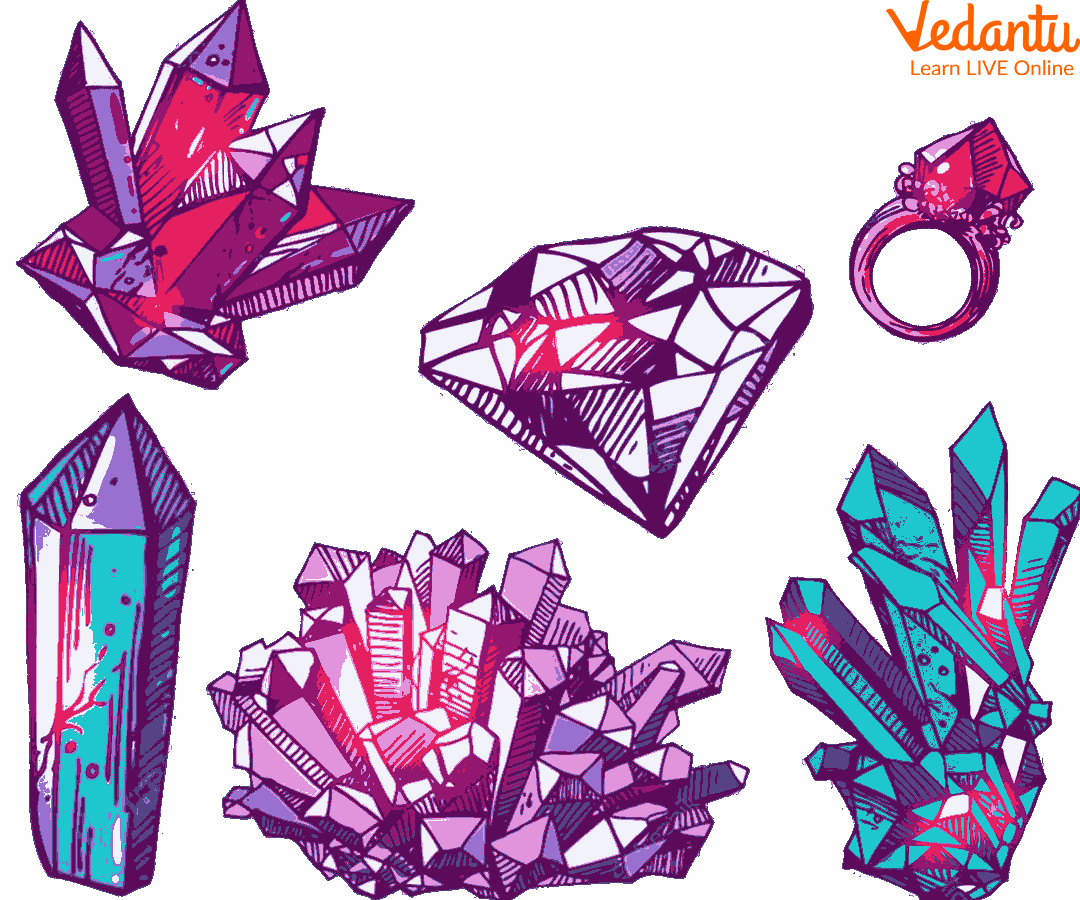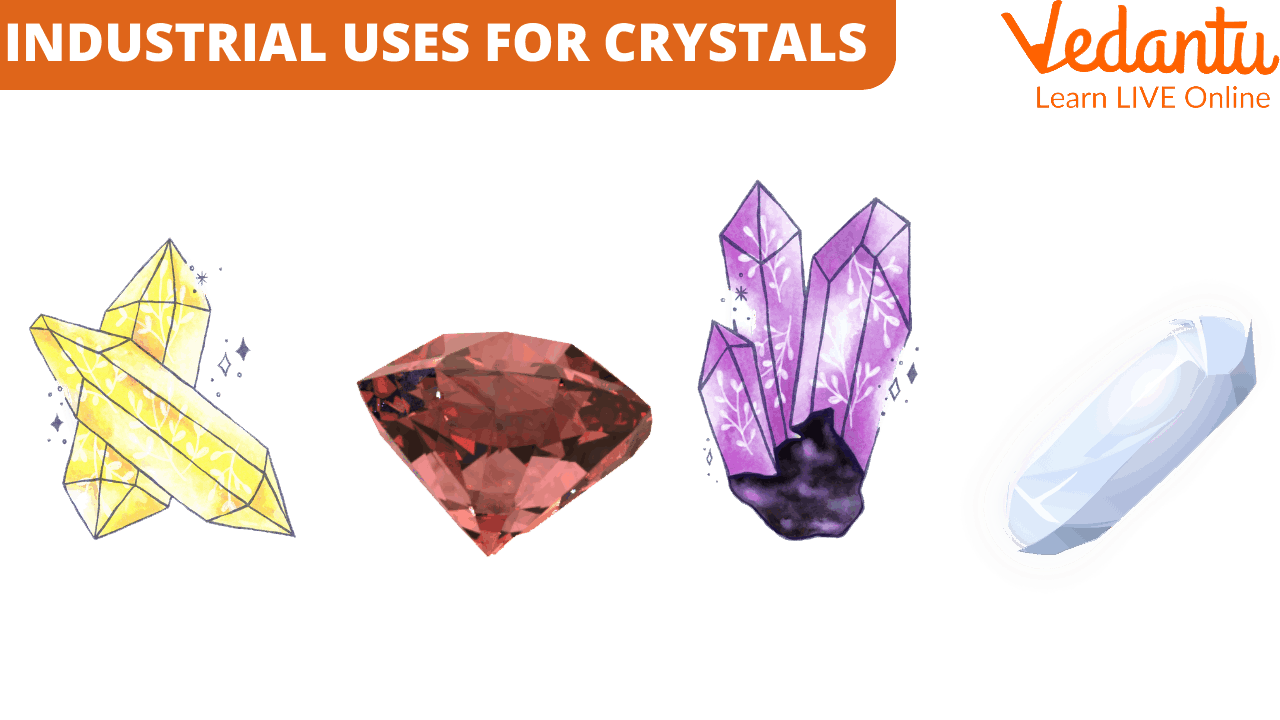




How Do Crystals Benefit Our Daily Lives and Technology?
We usually think of coloured minerals when we hear "crystal." But there are other kinds of crystals too. Crystals are also found in graphite, table salt, and snow.
Crystals all have a molecular structure that is very well put together. A crystal's atoms are lined up in a grid pattern. Table salt crystals (NaCl) are made of cubes of sodium (Na) ions and chlorine ions. Each sodium ion has six chlorine ions.
What is the Shape of Crystals?

Crystals Defined
The shape of a crystal is made by how the atoms or molecules of a substance fit together. Crystals can form in a lot of different ways. But crystals made of the same material all have the same shape. For example, the molecules of salt come together to form a cube. So, salt crystals are square cubes. Sugar crystals look like columns with points at the ends. Quartz crystals are six-sided columns. Not everything that is not made of crystals has the same shape. Glass breaks into many pieces of different sizes and shapes when it breaks.
What does Crystal Look Like?
People usually think of solids as hard and solid. But when you look closer, the definition becomes less clear. For example, a cube of butter kept in the fridge is complex and is a clear example of a solid. The same cube of butter gets very soft after a day on the kitchen counter, and it's not clear if the butter is still solid or not.
Many crystals are hard at low temperatures but soft at higher temperatures. When they are below their melting point, they are called solids. Solid is something that keeps its shape until one touches it. The important thing is how long the shape stays the same. A fluid with a lot of viscosity keeps its shape for an hour but not for a year. The shape of a solid must hold for longer than that.
Uses of Crystals in Everyday Life
People can use the crystals:
To meditate with crystals.
To decorate your room or office.
To make you feel happy
To use it as jewellery
Bring good luck by keeping it in your pocket.
Industrial Uses for Crystals

Use of Crystals in Industries
Early civilisations employed crystal sands to cut rock and stone, make jewellery and ornaments and engrave. Synthetic crystals were more robust, cheaper, and quicker to produce than natural crystals. Thus they rapidly found a market in many sectors:
Semiconductor Watches - Watchmakers employ quartz, ruby, and sapphire. Rolex watches have scratch-resistant sapphire glass. Synthetic ruby is used in the watch and mechanical bearings.
Cutting Diamonds and Dust - Diamond bits cut stone blocks and decorative stones in industrial saws and ropes. Oil well drills employ diamond-studded drill bits. Jewellers and lapidary artists utilise diamond saws, copper laps with diamond dust, and diamond cleaning powder for jade and sapphire.
Ruby-Laser - This 1960 red light beam has minimum divergence and is strong. CD players, long-distance phones, surveys, and microsurgery use it. The small ruby laser pointer helps college instructors in lectures. Lasers can cut steel and drill diamonds.
Uses of Crystals in Technology
Quartz crystals are used in sonar, ultrasound, radios, transistors, semiconductors, and digital timepieces.
They are used in electric guitars, microphones, and most digital electronics.
They're used in ovens, barbecues, heaters, and lighters.
Crystals: Some Interesting facts
Crystallography is the study of how crystals are made and how they grow.
Some crystals, like diamonds, are just one big molecule made up of many atoms of the same element.
Many computer screens use liquid crystals to show what's on the screen.
They are often used in jewellery because they can shine and come in various colours.
There are living things that can make crystals.
Conclusion
Most nonliving things are made of crystals. Things like sugar and salt are made of crystals. Gold, silver, copper, and iron are, too. Diamonds, emeralds, and other gems are also crystals. Some things look like they are made of crystals, but they are not. Glass is one of these things. Its molecules are put together in no way that makes sense.
FAQs on Uses of Crystals: Applications & Concepts Explained
1. What are crystals, and what makes them special?
A crystal is a solid material whose atoms, molecules, or ions are arranged in a highly ordered, repeating pattern. This internal structure extends in all three spatial dimensions. What makes them special is this perfect internal arrangement, which gives each type of crystal a unique, fixed shape and specific physical properties like hardness, colour, and the way it interacts with light and electricity.
2. How are crystals formed in nature?
Crystals are formed through a process called crystallisation. This typically happens in two main ways. First, when a hot, molten liquid like magma or lava cools down very slowly, it gives atoms time to arrange themselves into an orderly structure, forming crystals like quartz or diamond. Second, when water containing dissolved minerals evaporates, the minerals are left behind and can form crystals, such as common salt or sugar crystals.
3. What are some common uses of crystals in our daily lives?
Crystals have many uses that we encounter every day. Some common examples include:
- Jewellery and Decoration: Gemstones like diamonds, rubies, and sapphires are crystals valued for their beauty and durability.
- Food Seasoning: Common table salt and sugar are actually tiny crystals that we use to flavour our food.
- Timekeeping: Quartz crystals are used in watches and clocks to keep accurate time.
- Electronics: Liquid Crystal Displays (LCDs) are used in screens for TVs, computers, and calculators.
4. How are crystals used in technology and electronics?
The unique properties of crystals make them essential in modern technology. For example, silicon crystals are the foundation of all computer chips and semiconductors, acting as the brains of electronic devices. Quartz crystals are used to create precise electronic frequencies for radios, GPS devices, and computers. Furthermore, certain crystals like ruby are used to create lasers for applications ranging from surgery to data storage.
5. What is the difference between a crystal and a rock?
The main difference lies in their composition and structure. A crystal is a single, solid substance with a highly ordered and repeating atomic structure. A rock, on the other hand, is typically an aggregate or a mixture of one or more different minerals. While the minerals within a rock are often crystalline, the rock itself does not have a single, uniform crystal structure. For example, granite is a rock made of different mineral crystals like quartz and feldspar.
6. Why is Quartz crystal so important for making clocks and watches?
Quartz is crucial for timekeeping due to a special property called the piezoelectric effect. This means that when you apply a small amount of electricity to a quartz crystal (from a battery), it vibrates at an extremely precise and constant frequency—exactly 32,768 times per second. An electronic circuit counts these vibrations and uses them to advance the time, resulting in highly accurate and reliable clocks and watches.
7. What is a unit cell and why is it important for understanding crystals?
A unit cell is the smallest repeating unit of a crystal's atomic structure. You can think of it as a single building block or a tiny “brick.” The entire crystal is built by stacking these identical unit cells over and over again in three dimensions. Understanding the unit cell is important because its shape and the atoms it contains determine all the overall properties of the crystal, from its external shape to its hardness and electrical conductivity.
8. Why are diamonds used for cutting tools while other crystals are not?
Diamonds are used for cutting tools because of their extreme hardness. On the Mohs scale of mineral hardness, diamond scores a perfect 10, making it the hardest known natural substance. This exceptional hardness comes from its unique crystal structure, where carbon atoms are bonded together very strongly in a rigid, three-dimensional lattice. This allows a diamond to scratch or cut almost any other material, including steel and other rocks, which is why it's used in industrial saws, drill bits, and grinding tools.





















